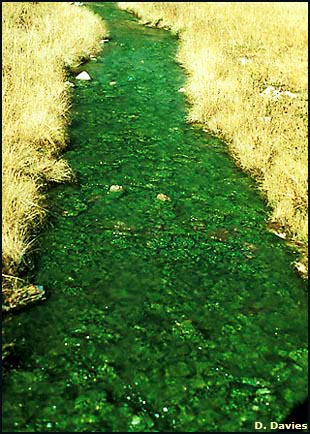A substantially updated version of the hypertextbook is available here. Please migrate to that version. This one will eventually disappear.
Objectives
The objectives of this section are:
to give you a glimpse of the wide variety of environments in which biofilms grow
to give you basic knowledge of the negative effects of biofilms grown on industry and medicine
to help you understand that biofilms are a naturally occurring and often beneficial phenomenon on earth
Outcomes
Upon completion of this section students will be able to:
recognize possible biofilm formations in the natural environment
appreciate the effect of harmful biofilms on industry
realize the harmful result of biofilms that grow on medical equipment and implants.
Where do biofilms grow?
Natural environments

This streambed in Yellowstone National Park is coated with biofilm that is several inches thick in places. The warm, nutrient-rich water provides an ideal home for this biofilm, which is heavily populated by green algae. The microbes colonizing thermal pools and springs in the Park give them their distinctive and unusual colors. More examples of these extremophilic bacterial communities can be viewed in the slide show below. Photo, above, courtesy of D. Davies.
Biofilms grow virtually everywhere, in almost any environment where there is a combination of moisture, nutrients, and a surface. Biofilms grow in rain forests and in deserts, as "desert varnish." They have been found at the bottom of the ocean as early colonizers of new deep-sea vents and living on glaciers in the Antarctic. Bacteria that live in these very hot or very cold environments are called extremophiles. Yellowstone National Park in the United States is home to an amazing array of colorful communities of extremophiles. In fact, the entire globe—both above and below ground—is "seeded" with the bacteria that form biofilms, and bacterial communities flourish, disperse or become dormant depending on changing environmental conditions.
Biofilms are an important life-link in many natural communities. These organisms form the basis for food webs that nourish larger organisms such as insect larvae, which are consumed by fish, that are in turn consumed by birds like eagles. Biofilms attached to particles of contaminated soils and aquatic sediments can help degrade soil-bound contaminants that occur from accidental chemical releases into the environment.
Plants commonly have microbial populations associated with their external tissues. One beneficial type of plant-microbe relationship occurs in the rhizosphere between the plant roots, root hairs and a complex microbial community. Plant roots secrete significant amounts of sugars, amino acids, vitamins and plant hormones that serve as nutrients for microbes to grow on root hairs. This microbial growth may facilitate the plant's ability to absorb nutrients from the soil.
Manufactured materials and systems
Microbes like to grow on surfaces, whether natural or manmade. When it comes to industrial surfaces, bacteria are just doing "what comes naturally" by attaching to the surfaces with which they come into contact. However, their propensity for attachment causes many problems for a wide range of industries. Biofilm contamination and fouling occur in nearly every industrial water-based process, including water treatment and distribution, pulp and paper manufacturing and the operation of cooling towers. Biofilms are responsible for billions of dollars in lost industrial productivity, as well as product and capital equipment damage each year. Biofilms are notorious for causing pipe plugging, corrosion and water contamination.
Click to see Table 1-1, a summary of manufactured surfaces and systems affected by biofilm formation, associated impacts, and journal references.
Health and the human body
This may come as something of a shock to you, but about 90 percent of the cells in a human body are not human! In fact, the human body is heavily colonized by microbes that have found it a great place to live. We have communities of microbes living on all mucous surfaces and in our digestive tract, as well as on and in layers of our skin. For the most part we all get along; in fact, we depend on some of our gut microbes to help with digestion. Sometimes, however, the microbial load causes problems of infection. Dentists now understand, for instance, that dental caries (cavities) are the result of bacterial infection (and biofilms!). When the normal balance of microbial populations is upset or when our immune system is overwhelmed, we can have a real battle with microbial opportunists.
In the 1990s, as the biofilm concept was being introduced to the medical community, doctors began to make the connection between chronic, low-grade infections and the biofilm mode of growth. Dental professionals made the connection easily, as teeth could readily be scraped for microscopic examination. Internal cases of chronic infection have taken longer to prove, but testing has shown that many troublesome diseases have entrenched microbial populations at their core. Peptic ulcers, once thought to be caused by stress, have been proved to be caused by bacterial communities of Helicobacter pylori. The cyclical flare-up and subsidence of otitis media—the most common cause of children's recurrent earaches—is an example of a typical biofilm-based infection. Click to see Table 1-2, a summary of biofilms in medical contexts, the associated impacts, and journal references.


